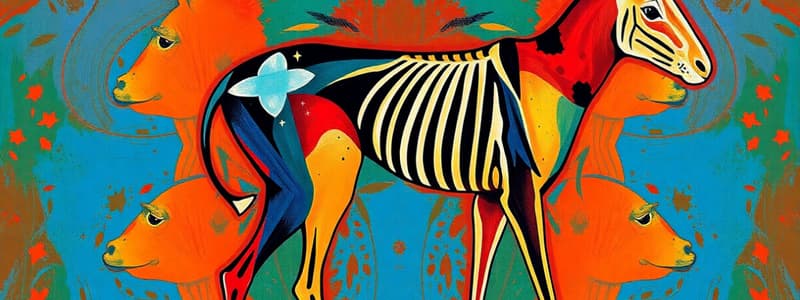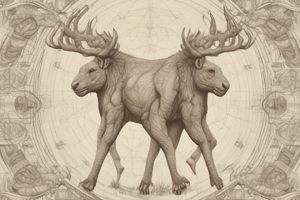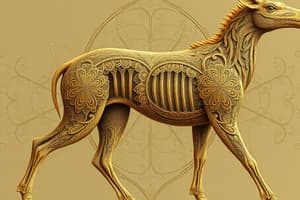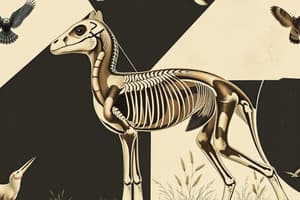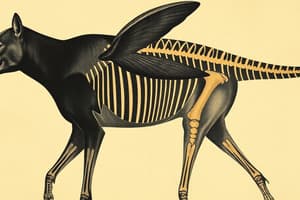Podcast
Questions and Answers
What type of symmetry do humans exhibit?
What type of symmetry do humans exhibit?
- Asymmetrical symmetry
- Bilateral symmetry (correct)
- Pentaradial symmetry
- Radial symmetry
What characterizes animals that have a true body cavity?
What characterizes animals that have a true body cavity?
- They lack any organ systems.
- They possess a coelom that separates organs from body tissue. (correct)
- Their organs are not separated from body tissue.
- They have a pseudocoelom without any organ differentiation.
Which term describes animals that develop their mouth before their anus?
Which term describes animals that develop their mouth before their anus?
- Protostomes (correct)
- Coelomates
- Deuterostomes
- Eumetazoans
What distinguishes eumetazoans from other animal classifications?
What distinguishes eumetazoans from other animal classifications?
Which type of symmetry tends to indicate high mobility in animals?
Which type of symmetry tends to indicate high mobility in animals?
How can the location of body structures cause confusion in communication about animals?
How can the location of body structures cause confusion in communication about animals?
What is the opposite side of the ventral side in animal anatomy?
What is the opposite side of the ventral side in animal anatomy?
What defines an animal's body plan?
What defines an animal's body plan?
Which of the following best describes radial symmetry?
Which of the following best describes radial symmetry?
Which type of symmetry is primarily found in sponges?
Which type of symmetry is primarily found in sponges?
Why do animal body plans have a significant role in biology?
Why do animal body plans have a significant role in biology?
What aspect of an animal's anatomy is NOT considered a feature of its body plan?
What aspect of an animal's anatomy is NOT considered a feature of its body plan?
Which statement about bilateral symmetry is accurate?
Which statement about bilateral symmetry is accurate?
What happens to the symmetry of a flounder as it matures?
What happens to the symmetry of a flounder as it matures?
Which of the following statements is true regarding the evolution of animal body plans?
Which of the following statements is true regarding the evolution of animal body plans?
Flashcards are hidden until you start studying
Study Notes
Animal Body Plans
- An animal body plan encompasses the organization and combination of an animal's body parts and features.
- Key features include:
- Body segmentation
- Body symmetry
- Limb disposition
- Tissue and organ structure
- While animals may have different appearances, they can share the same body plan.
- For example, a Great Dane and a Chihuahua share the same body plan despite size differences.
- Most animal body plans arose after the Cambrian Explosion, which occurred around 542 million years ago.
- Body plans evolve to help animals survive in their environments.
- Animal body plans are crucial for understanding evolutionary and developmental biology, allowing for classification and better comprehension of animal diversity.
Body Symmetry
-
Asymmetry:
- No symmetry in the body plan.
- Found in the phylum Porifera (sponges).
- Example: Sponges
-
Radial Symmetry:
- Animal looks the same from its center in all directions.
- No distinct right or left side.
- Found in sedentary aquatic animals.
- Example: Sea jellies and coral
-
Bilateral Symmetry:
- Two distinct halves that are mirror images of each other.
- Animals tend to be highly mobile and can live in both aquatic and land environments.
- Example: Humans, butterflies, and most mammals
Structures
- Body Cavities:
- Coelom: True body cavity, allows organ growth and separation from body tissue.
- Pseudocoelom: Acts like a coelom but does not have tissue lining the entire cavity.
- Acoelomate: Lacking both coelom and pseudocoelom.
- Tissues:
- True Tissues: Specialized cells and tissues with specific tasks (example: muscles, organs, ligaments).
- Eumetazoans: Animals with true tissues.
- Mouth Development:
- Protostomes: Animals that develop their mouth before the anus.
- Deuterostomes: Animals that develop their anus before their mouth (example: Humans).
Body Regions
- Anterior: Head end of the animal.
- Posterior: Opposite end of the anterior, often referred to as the tail-end
- Dorsal: Backside of the animal.
- Ventral: Bottom of the animal.
Studying That Suits You
Use AI to generate personalized quizzes and flashcards to suit your learning preferences.
